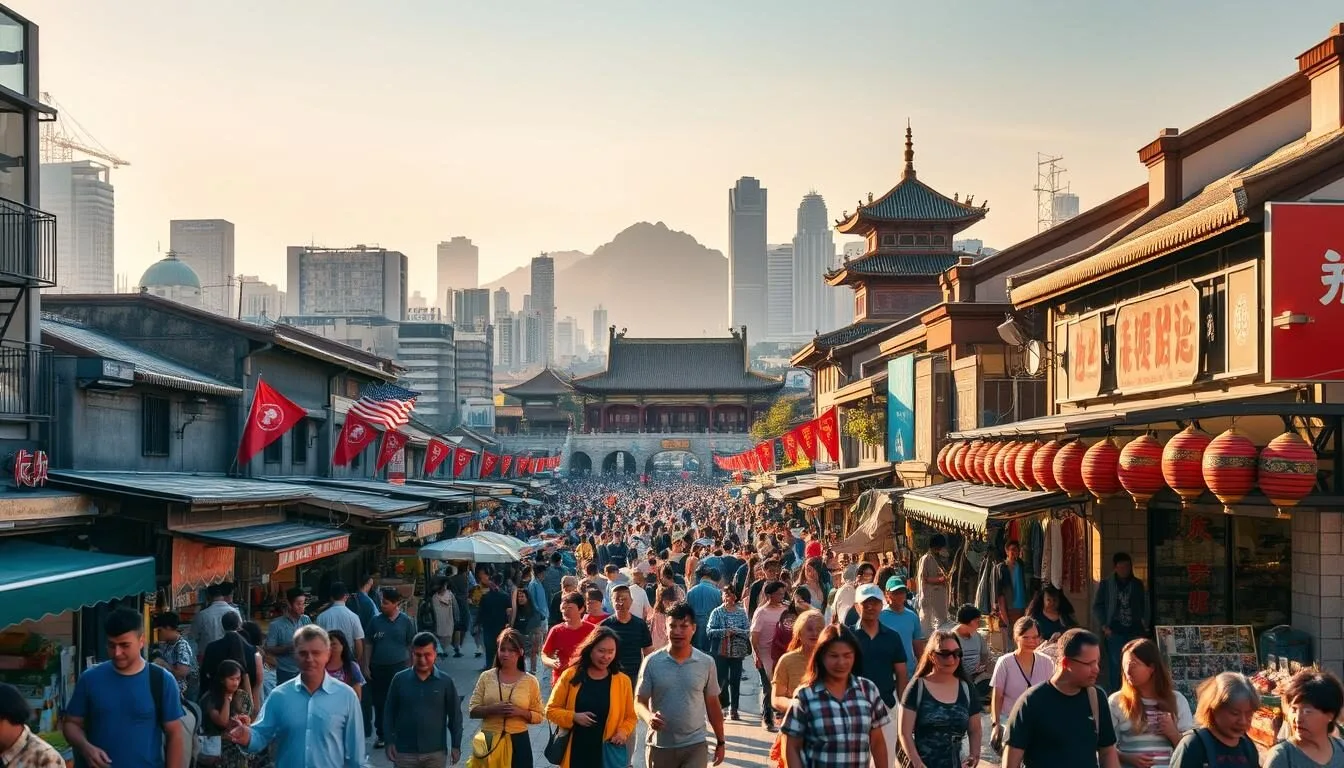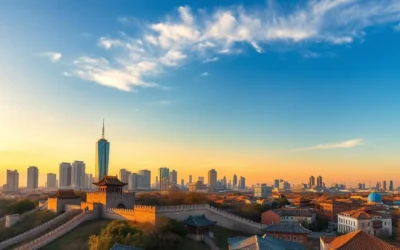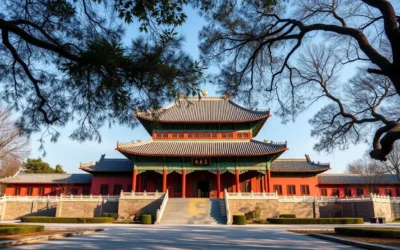✓ Accommodations✓ Flights✓ Rental Cars✓ Tours & Activities
Imagine walking through a city where ancient history and modern life blend seamlessly together. Nanjing, the capital of Jiangsu Province, is a treasure trove of cultural heritage and natural beauty, making it a must-visit destination in China.
As one of China’s Four Great Ancient Capitals, Nanjing boasts a rich history, having served as the capital city for six dynasties. You’ll discover imperial mausoleums, serene lakes, and a plethora of historical monuments, including the Ming tombs on the UNESCO World Heritage List.
Whether you’re planning a short visit or an extended stay, Nanjing offers a perfect balance of cultural immersion, historical discovery, and natural beauty. Get ready to explore the top attractions that showcase this city’s unique blend of imperial grandeur and revolutionary history.
Discovering Nanjing: The Southern Capital of China
As you step into Nanjing, you’re not just entering a city, you’re stepping into a rich tapestry of history that spans centuries. With an estimated urban population of 8 million people, Nanjing is a major commercial and trade city located in East China’s Yangtze River Delta. The city’s strategic location, with the Yangtze River flowing through it and its proximity to Taihu Lake, has played a significant role in shaping its development throughout history.
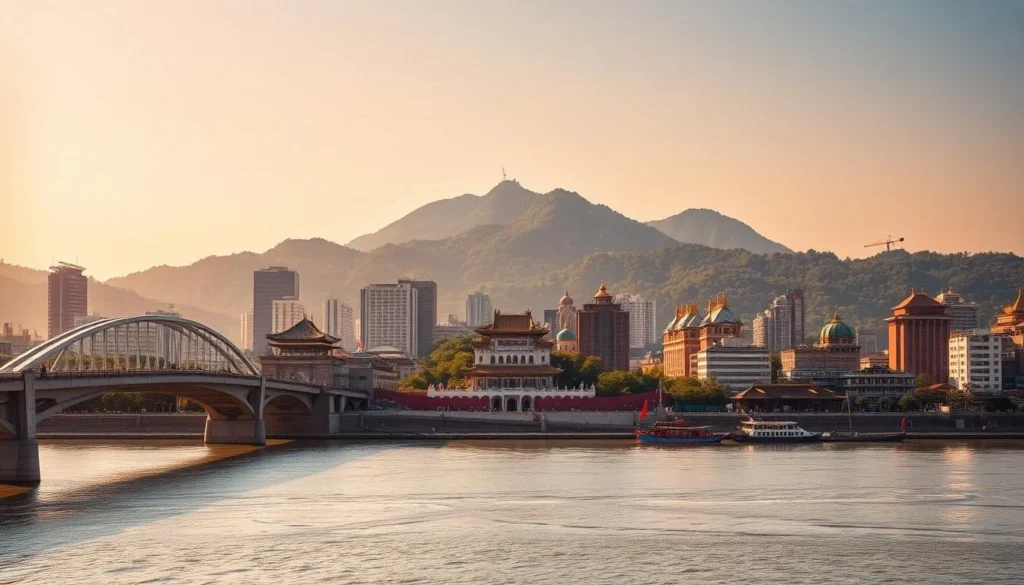
Historical Significance as One of China’s Four Great Ancient Capitals
Nanjing’s historical significance is profound, having served as the capital for multiple dynasties, including the Ming Dynasty. This legacy has left behind a rich culture and architectural heritage that is still palpable today. As one of China’s Four Great Ancient Capitals, Nanjing’s history is a testament to its importance in the country’s past, earning it a revered place in Chinese history. You’ll discover why Nanjing earned its name as the “Southern Capital” and how its historical significance contributes to its world-class attractions and cultural sites.
- Nanjing served as the capital for several dynasties, leaving a lasting legacy.
- The city’s historical significance is reflected in its cultural and architectural heritage.
- Nanjing’s role as one of China’s Four Great Ancient Capitals underscores its importance in Chinese history.
Overview of Modern Nanjing’s Layout and Districts
Modern Nanjing is a city that balances its historical heritage with contemporary development. The city is divided into 11 districts, with Gulou being the traditional heart of the city, housing the cultural and administrative centers. Xuanwu District is home to many of Nanjing’s tourist attractions, including Xuanwu Lake and Dr. Sun Yat-Sen Mausoleum. In contrast, Jianye and Yuhuatai Districts represent the city’s modern face, with skyscrapers, electric trams, and industrial centers for well-known enterprises. You’ll learn how Nanjing guides you through its modern layout, highlighting key districts and understanding how the city honors its past while embracing the future.
Nanjing’s modern layout is a blend of traditional and contemporary elements, making it a unique city that offers a blend of old and new. The city’s districts are designed to preserve its historical significance while promoting modern development, creating a vibrant and dynamic urban environment that is recognized worldwide.
Best Time to Visit Nanjing
When planning your trip to Nanjing, understanding the best time to visit is crucial for a comfortable and enjoyable experience. Nanjing, known for its historical significance and cultural heritage, has a climate that varies significantly throughout the year.
Spring and Fall: Ideal Seasons for Comfortable Sightseeing
The most pleasant seasons in Nanjing are Spring (April to May) and Fall (September to November). During these periods, the cool breezes and mild temperatures make them ideal for sightseeing. Spring is characterized by warm and humid weather, with less rainfall and an average temperature of 26 °C (78 °F), making it perfect for outdoor activities and viewing blossoming flowers. On the other hand, Fall offers pleasantly cool and dry weather, providing a comfortable environment for exploring Nanjing’s many attractions.
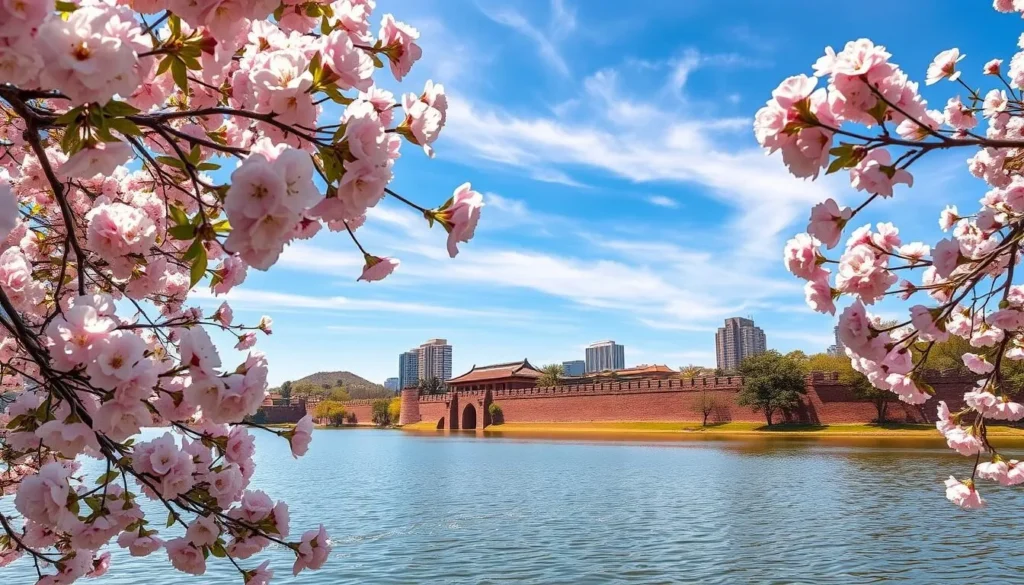
- Enjoy comfortable weather during Spring and Fall, ideal for sightseeing.
- Avoid visiting on weekends or during national holiday periods like Labor Day or Chinese New Year when tourist areas get crowded.
Seasonal Highlights and Events to Plan Around
Nanjing offers various seasonal highlights and events that can enhance your trip. In the Spring, you can enjoy the blossoming plum blossoms, while Autumn brings spectacular maple foliage to places like Purple Mountain. Be aware that Summer can be challenging due to Nanjing’s reputation as one of China’s “furnace cities,” with temperatures often exceeding 95°F. Additionally, consider planning around major Chinese holidays and seasonal events like the Qinhuai Lantern Festival during Chinese New Year.
- Experience the beauty of Spring’s plum blossoms and Fall’s maple foliage.
- Plan your trip around major Chinese holidays to avoid crowds.
- Enjoy seasonal events like the Qinhuai Lantern Festival.
Understanding the impact of different seasons on air quality and visibility can also help you plan your sightseeing activities, especially at Nanjing’s panoramic viewpoints.
Getting Around Nanjing: Transportation Tips
Getting around Nanjing is a breeze, thanks to its comprehensive transportation system. As a city that attracts millions of visitors each year, Nanjing has developed a travel guide that makes exploring its historic sites and modern attractions surprisingly easy and affordable.
Navigating the Metro System and Sightseeing Bus Routes
Nanjing’s metro system is a convenient way to travel across the city, with 10 lines covering most areas of interest. Lines 1, 2, 3, and 10 are particularly useful for tourists, as they stop at major attractions like the Purple Mountain, Confucius Temple, and Xuanwu Lake. The metro fare starts at 2 RMB, and most journeys cost between 2 to 7 RMB.
In addition to the metro, Nanjing offers five special sightseeing bus routes (Y1-Y5) designed to help visitors explore the city’s scenic spots. For example, Route Y1 connects Nanjing Railway Station to Dr. Sun Yat-Sen Mausoleum, while Route Y2 takes you from Yuhua Tai to Nanking Underwater World via several key attractions. A 24-hour pass for these sightseeing buses costs 30 RMB, offering excellent value for money.
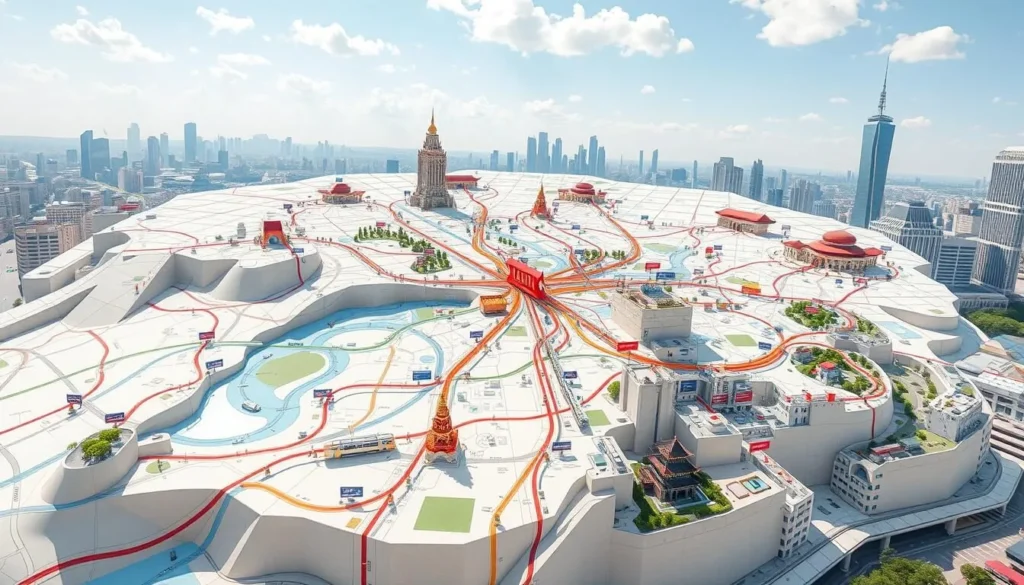
Taxis, Ride-Sharing, and Walking Options
For shorter journeys or when you prefer a more direct route, taxis and ride-sharing services are readily available in Nanjing. To ensure safety, it’s recommended to use licensed taxi services or reputable ride-sharing apps. The city center is also quite walkable, allowing you to explore historic neighborhoods on foot and discover local gems along the way.
When walking, you can enjoy the city’s vibrant atmosphere and visit attractions that are close to each other. For instance, the area around Confucius Temple is perfect for a leisurely stroll, with its traditional architecture, lively street food scene, and shopping districts.
Whether you’re traveling to the outskirts or staying within the city center, Nanjing’s transportation options provide a convenient and affordable way to experience all that this historic city has to offer.
Top Historical Attractions in Nanjing
As one of China’s four great ancient capitals, Nanjing boasts an array of historical attractions that are not to be missed. You’ll have the opportunity to explore some of the city’s most significant landmarks, each offering a unique glimpse into Nanjing’s rich history.
Sun Yat-sen Mausoleum: Tribute to the Father of Modern China
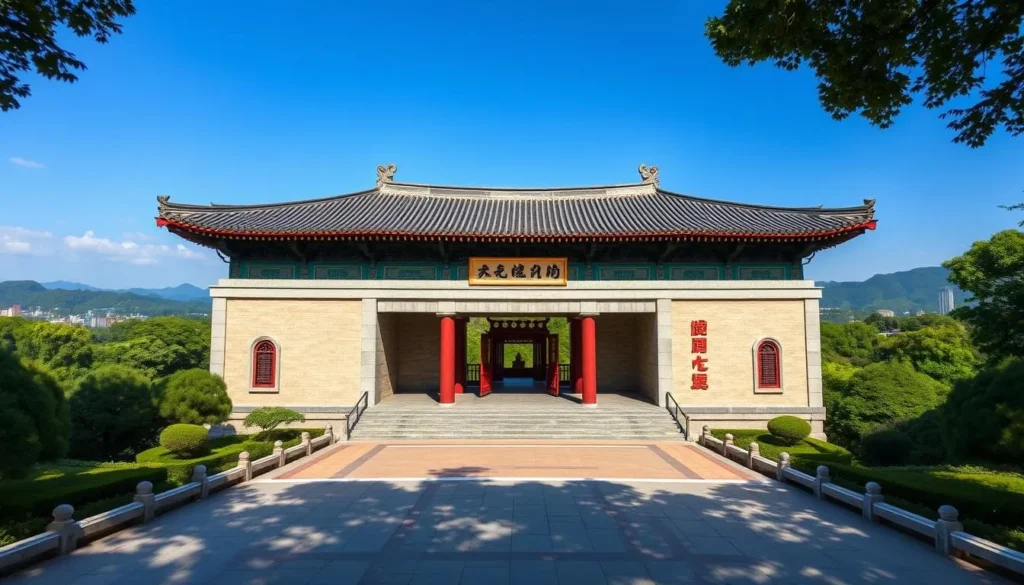
The Sun Yat-sen Mausoleum is a magnificent tribute to the founding father of the Republic of China. With its impressive 392-step ascent, you’ll be rewarded with breathtaking hilltop views. The mausoleum is not only a great insight into China’s history but also a beautiful place to explore, with shaded areas to rest and a statue of Dr. Sun Yat-sen to admire.
As you climb the steps, you’ll notice benches on each platform, allowing you to pause and take in the surroundings. The sight at the top is truly spectacular, offering a panoramic view of the city.
The Ancient City Wall: Ming Dynasty Engineering Marvel
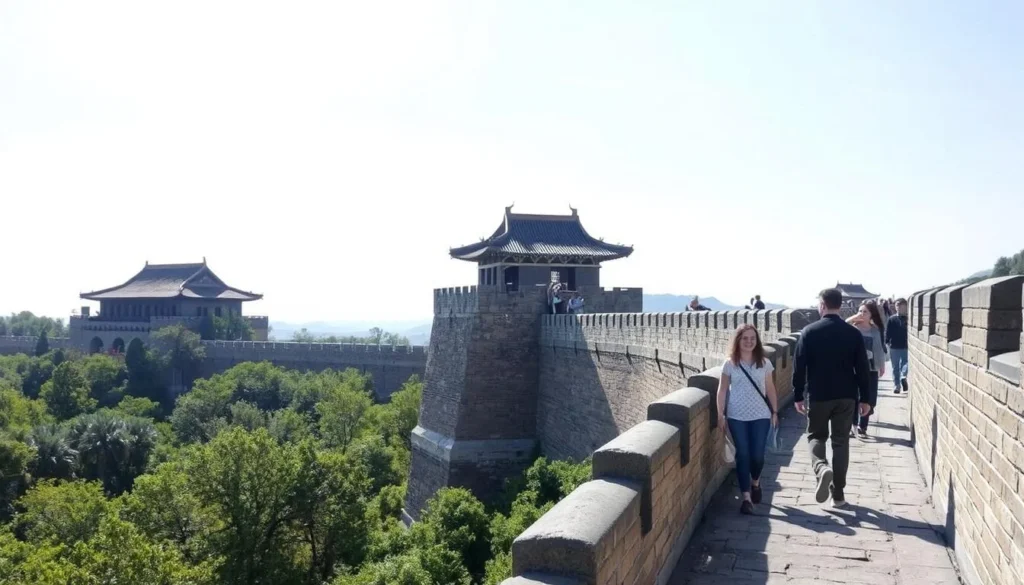
The Ancient City Wall of Nanjing is one of the best-preserved Ming Dynasty fortifications in China. As you walk along its centuries-old stones, you’ll be transported back in time, enjoying sweeping views of the city. This historical landmark is a testament to the engineering prowess of the Ming Dynasty and offers a unique perspective on Nanjing’s past.
The City Wall is not just a historical relic; it’s an immersive experience that allows you to connect with the city’s rich history while taking in its modern landscape.
Presidential Palace: Witness to China’s Political Evolution
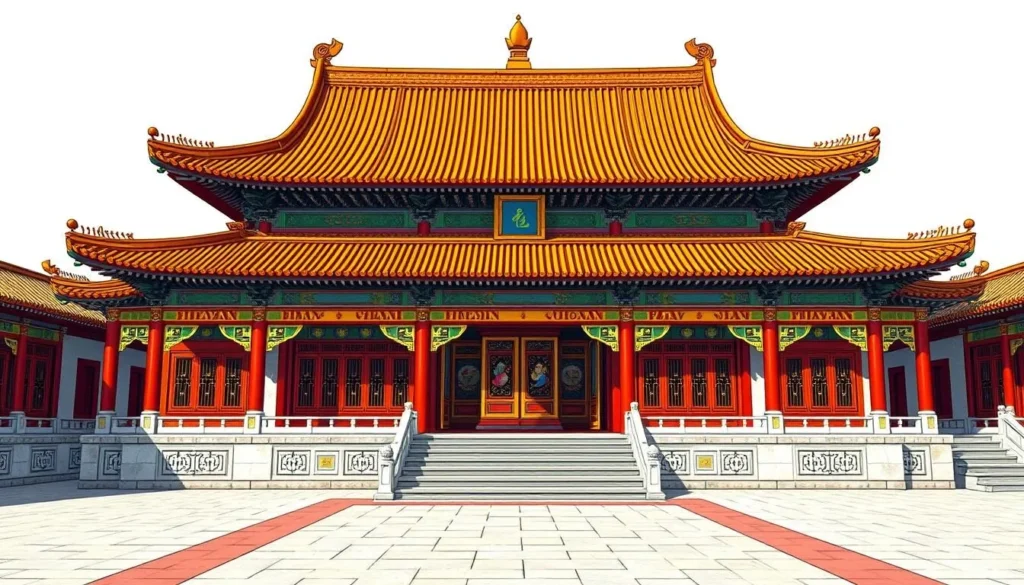
The Presidential Palace served as the political center during crucial periods in China’s modern history, including the Opium War and the Liberation War from 1840 to 1949. This historic site is now the largest museum of modern Chinese history and features a classic South China garden with pavilions, trees, and lakes.
As you explore the palace, you’ll discover three distinct exhibition areas: the national government office, the temporary president’s office, and the executive council chambers. Each area provides a unique insight into China’s political evolution and the role of the Presidential Palace in shaping the country’s history.
In conclusion, Nanjing’s historical attractions offer a compelling journey through China’s past, from the Ming Dynasty to the Republic era. By visiting these sites, you’ll gain a deeper understanding of the city’s significance in Chinese history and appreciate its architectural and cultural heritage.
Purple Mountain: Nature and History Combined
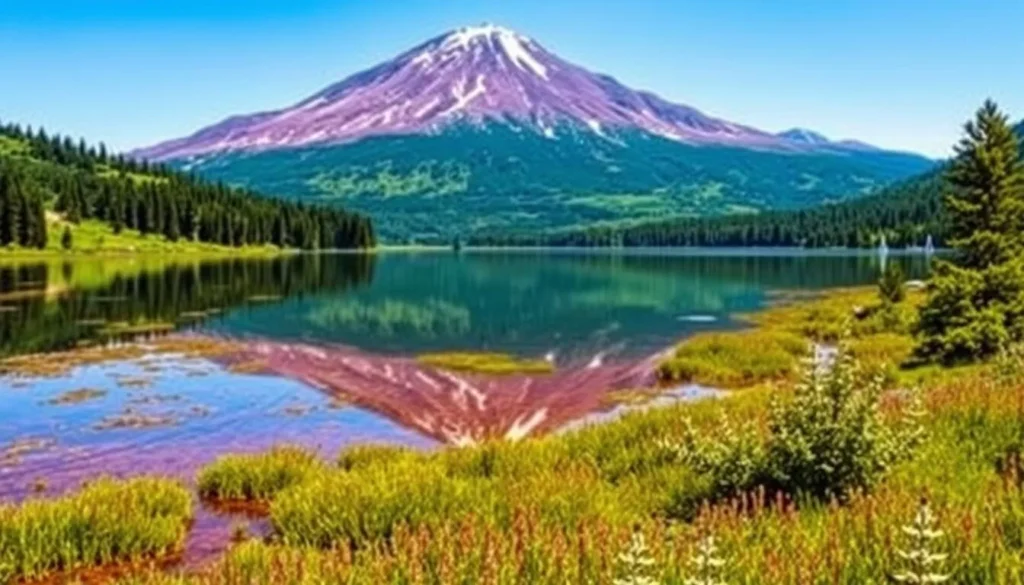
As you explore Nanjing, a visit to Purple Mountain is a must to experience the perfect blend of natural beauty and historical significance. Praised as “the First Mountain of Chinese Humanism,” Purple Mountain is a treasure trove of history, with many emperors and heroes from over ten dynasties laid to rest here.
Hiking Trails and Scenic Viewpoints
You’ll discover that Purple Mountain is crisscrossed with hiking trails that lead to spectacular viewpoints. These trails are especially beautiful during autumn when the foliage turns vibrant red and gold, offering a breathtaking view that’s sure to leave you in awe.
Historical Sites Within the Mountain Area
The mountain is home to numerous historical sites, including the Mausoleum of Sun Yat-sen, a significant cultural relic that honors the first president of the Republic of China. As you explore these sites, you’ll gain a deeper understanding of the historical significance of Purple Mountain and its importance in Chinese history.
The Unique Pigeon Experience at the Open Air Music Stage
One of the unique attractions at Purple Mountain is the Open Air Music Stage, a stone-shaped amphitheater-style theater where you can have a memorable experience. Especially in autumn, the area is filled with friendly pigeons that will perch on your hands and shoulders, creating a truly unforgettable experience.
As you plan your visit to Purple Mountain, you’ll find that it’s a destination that seamlessly combines natural beauty with historical significance, offering something for everyone. Whether you’re interested in hiking, history, or simply enjoying the scenery, Purple Mountain is a must-visit destination in Nanjing.
Serene Waters: Lakes and Rivers of Nanjing
Nanjing’s waterways are a defining feature of the city, offering a unique blend of natural and cultural attractions. As you explore these serene waters, you’ll discover the perfect blend of relaxation and cultural experiences that Nanjing has to offer.
Xuanwu Lake: City Center Oasis
Xuanwu Lake is a stunning city center oasis that offers a peaceful escape from Nanjing’s urban energy. Walking around the lake is a great way to unwind and relax, surrounded by plenty of green scenery and fresh air. The lake’s tranquil atmosphere is enhanced by its harmonious, quiet, clean, and beautiful surroundings.
Watching the sunset where the skyline meets the lake is a Nanjing experience you won’t want to miss. Alternatively, boating on the lake is a great way to enjoy the great views of the city skyline. For an affordable price, you can rent a paddle boat and explore the lake in a whole different way.
The best time to visit Xuanwu Lake is in July when the lotus flowers are in full bloom, standing almost six feet tall in the lake. This natural spectacle is a must-see during your visit to Nanjing.
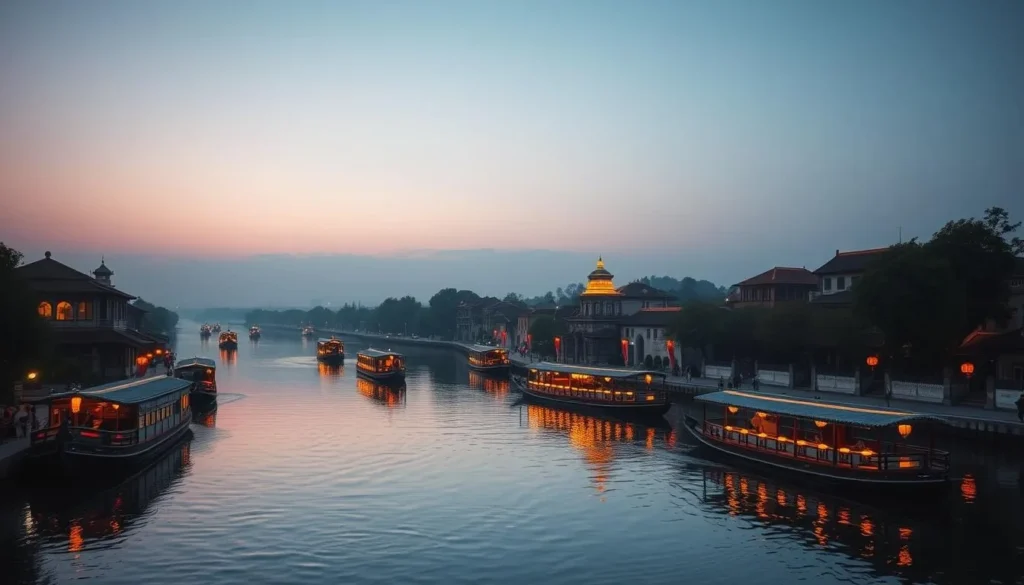
Qinhuai River: Evening Cruises and Riverside Culture
The Qinhuai River is Nanjing’s “mother river” that flows through the heart of the old city, lined with historic buildings and vibrant nightlife. A vibrant cultural hub along the Qinhuai River is filled with traditional lantern-lit boats, historic architecture, and a bustling night market.
An evening boat ride along the Qinhuai River is a magical experience, where lantern-lit cruises offer spectacular views of illuminated bridges and riverside architecture. This is a great way to enjoy the city’s cultural heritage and nightlife.
The Qinhuai River has played a significant role in Nanjing’s development and continues to shape city life today. As you explore the river, you’ll gain a deeper understanding of the city’s history and culture.
Cultural and Religious Sites Worth Visiting
As you wander through Nanjing, you’ll discover a wealth of cultural and religious landmarks that showcase the city’s rich heritage. The city’s cultural landscape is a testament to its historical significance as one of China’s four great ancient capitals.
Confucius Temple: Cultural Hub and Shopping District
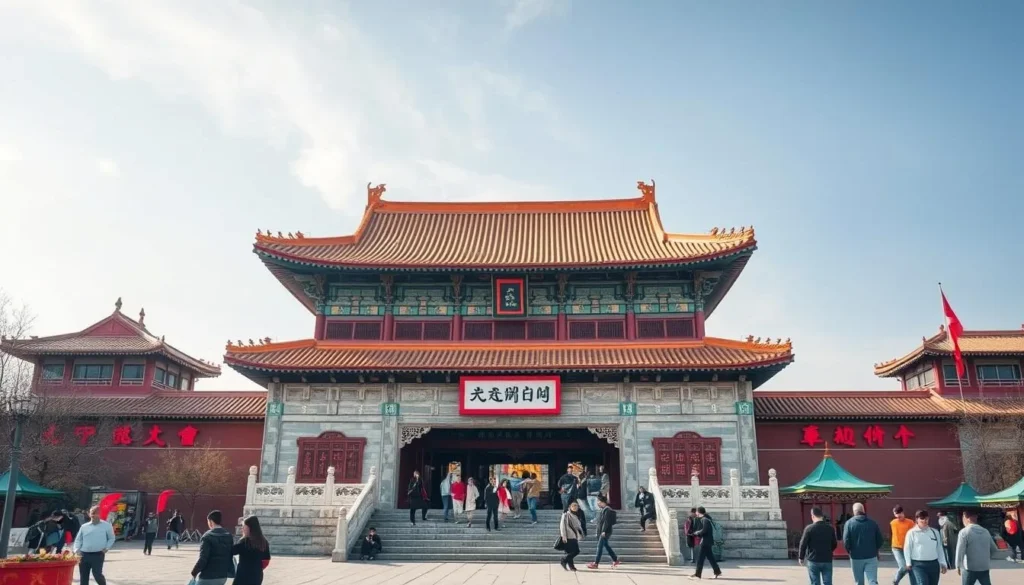
The Confucius Temple, or Fuzimiao, is a cultural complex that honors China’s greatest philosopher while serving as a vibrant commercial and entertainment district. You’ll explore the temple’s three main areas: the temple itself, Jiangnan Gongyuan (imperial examination hall), and Xuegong (ancient academy). The temple complex is especially lively during Chinese New Year, offering a glimpse into traditional Chinese culture and a festive atmosphere.
The Confucius Temple is not only a significant cultural site but also a hub for shopping and entertainment. You can enjoy the intricate wooden carvings and traditional architecture while browsing through the local shops and stalls.
Jiming Temple: Buddhist Architecture and City Views
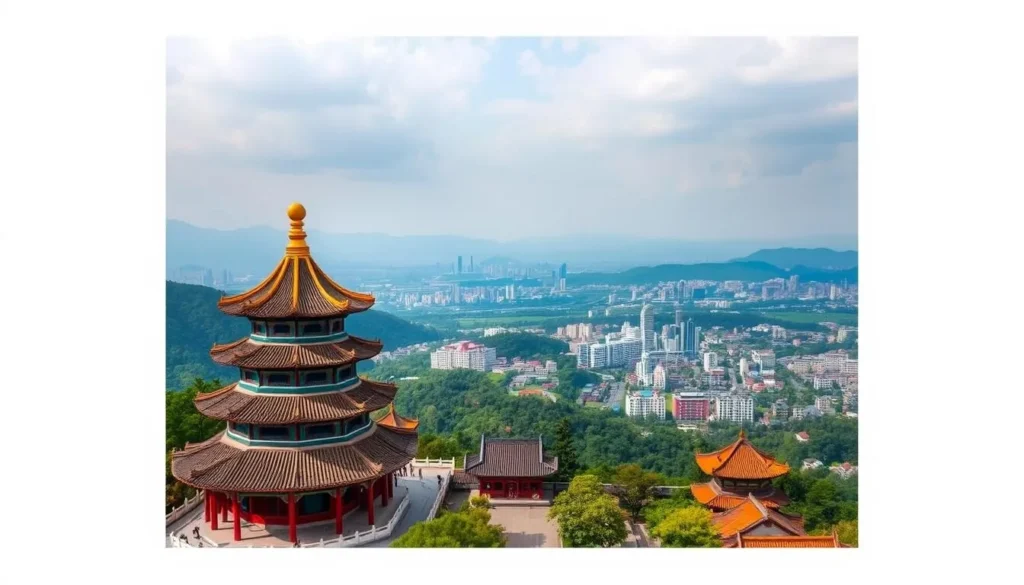
You’ll discover Jiming Temple, one of Nanjing’s oldest Buddhist temples, perched on a hillside with spectacular views of the city and Xuanwu Lake. The temple’s Buddhist architecture is characterized by its golden roofs and intricate designs. From the temple, you can access the city wall and enjoy gorgeous views of Nanjing.
Inside the temple complex, you’ll find typical Chinese pavilions with Buddha images, as well as impressive pictures, paintings, and sculptures.
Linggu Temple and Beamless Hall
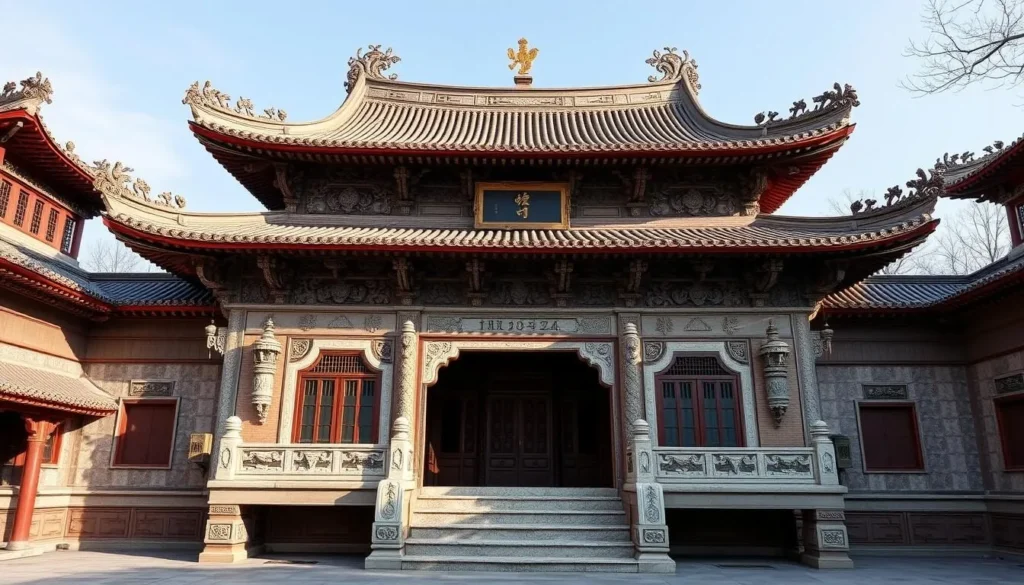
You’ll learn about Linggu Temple and its famous Beamless Hall, a Ming Dynasty architectural marvel constructed entirely without beams. This unique structure is a testament to the ingenuity of ancient Chinese architects. The temple complex is a significant cultural and religious site, reflecting the importance of Buddhism in Chinese culture.
The Linggu Temple is a must-visit for anyone interested in history, architecture, and culture. Its serene surroundings and historical significance make it a memorable experience.
Museums and Memorial Sites in Nanjing
As you explore Nanjing, you’ll discover a wealth of museums and memorial sites that showcase the city’s complex past and cultural significance. These institutions not only preserve the history of Nanjing but also provide a poignant reminder of the events that have shaped the city and its people.
Nanjing Museum: Treasures of Chinese Civilization
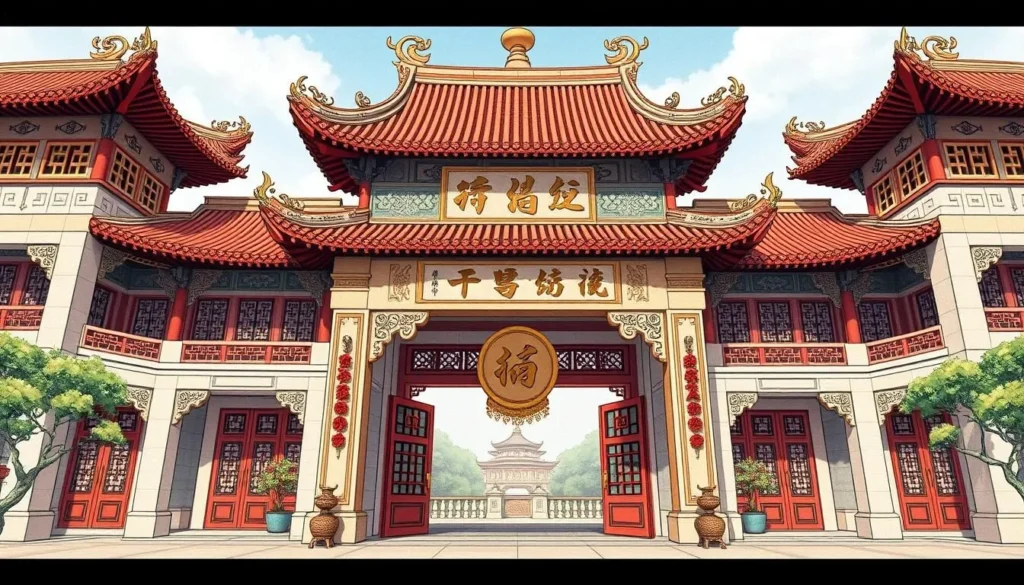
The Nanjing Museum is one of China’s oldest and most comprehensive museums, housing over 400,000 artifacts that span Chinese civilization. You’ll explore exhibits featuring ancient artifacts, intricate calligraphy, and treasures from the Ming and Qing Dynasties. The museum’s collections offer a fascinating glimpse into China’s rich cultural heritage.
Memorial Hall of the Nanjing Massacre: A Solemn Historical Reminder
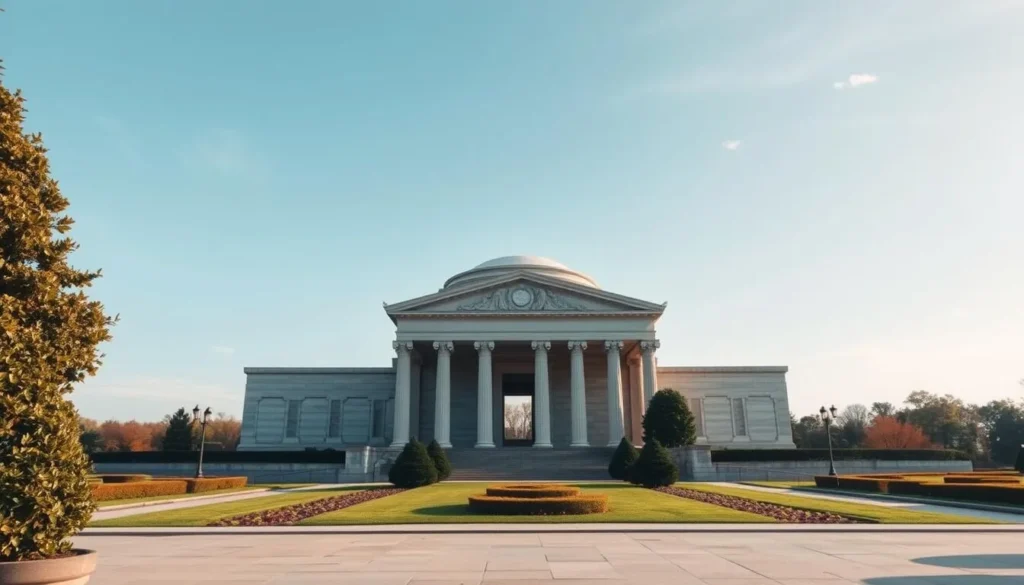
The Memorial Hall of the Nanjing Massacre is a sobering but essential site that commemorates the tragic events of 1937. The memorial pays tribute to the hundreds of thousands of Chinese civilians who were murdered during the massacre. It’s a place to learn from history and reflect on the importance of peace and reconciliation.
Porcelain Tower (Bao’en Temple): Ancient Wonder Rebuilt
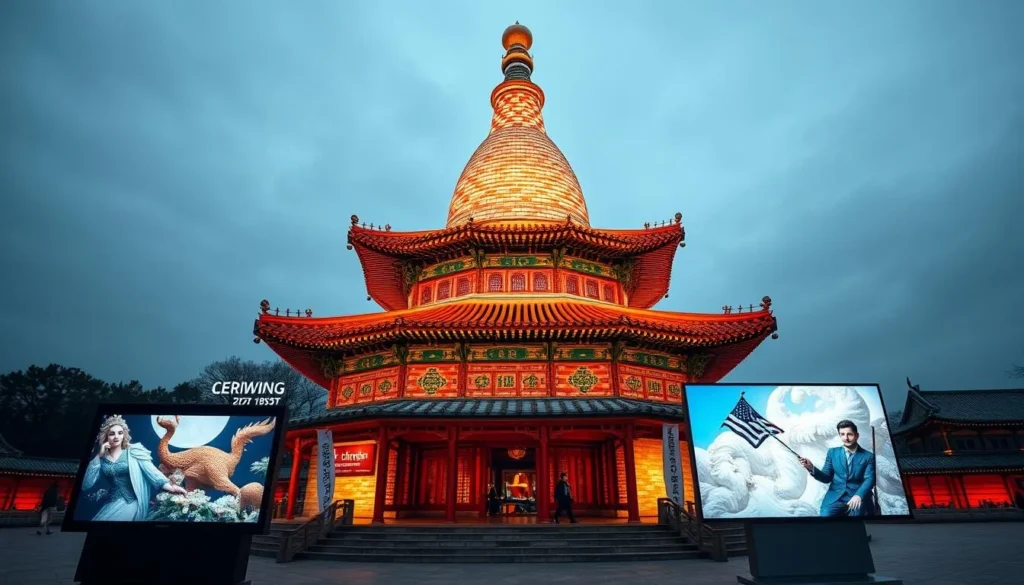
The Porcelain Tower, also known as Bao’en Temple, is one of the most iconic landmarks in Nanjing. Originally built during the Ming Dynasty, the temple was destroyed but has since been reconstructed. Today, it stands as a testament to the city’s rich history and cultural significance, featuring gleaming porcelain bricks and modern multimedia exhibits.
Nanjing’s museums and memorial sites offer a unique perspective on the city’s history and cultural heritage. By visiting these institutions, you’ll gain a deeper understanding of China’s complex past and the significance of preserving historical truths.
Nanjing, China: Best Things to Do for Nature Lovers
Discover the natural side of Nanjing, where mountains, lakes, and flowers await your exploration. Nanjing is a paradise for nature lovers, with its abundance of parks, mountains, and seasonal natural displays.
Autumn Foliage at Maple Color City and Qixia Mountain
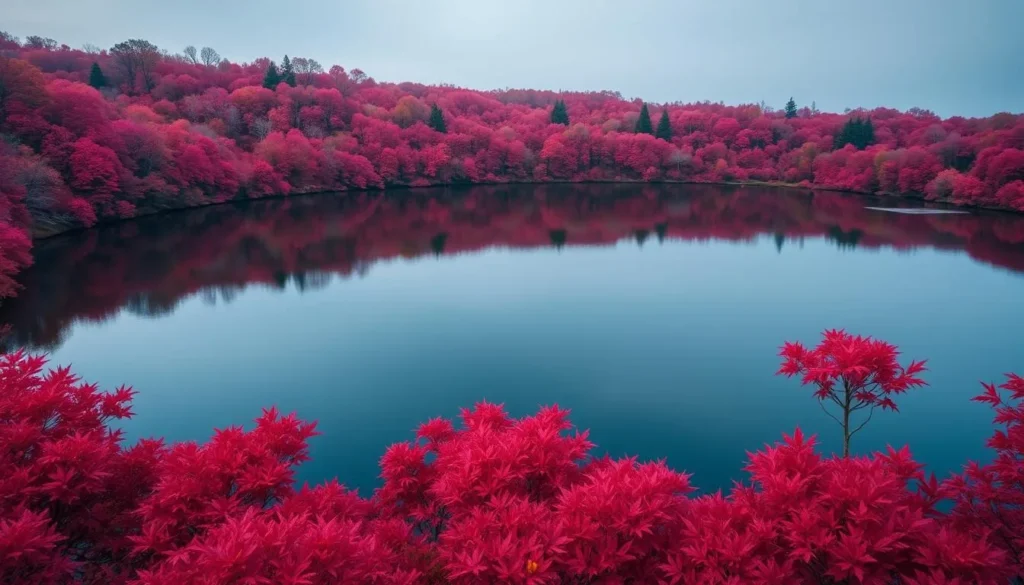
Maple Color City is a must-visit during autumn, with its stunning landscape of vibrant red maples around a serene lake. The air is fresh, and the atmosphere is peaceful, making it an ideal spot for nature enthusiasts. You can reach Maple Color City by taking the S8 Line to Xiongzhou Station, followed by a 3-hour bus ride or a 45-minute car journey.
Another gem for autumn foliage is Qixia Mountain, famous for its Buddhist temple and the breathtaking fall colors. The forests transform into a canvas of red, orange, and gold, creating a picturesque scene.
Seasonal Flower Viewing: Plum Blossoms and Lotus Flowers
Nanjing is also renowned for its seasonal flower viewing opportunities. In early spring, the delicate plum blossoms are a treat to behold. Later, in summer, the magnificent lotus flowers bloom across Xuanwu Lake, creating a serene and beautiful landscape.
Xuanwu Lake Park is one of the largest Imperial lake gardens in China, located at the foot of Purple Mountain. Visitors can leisurely stroll around scenic spots, teahouses, pavilions, and historic sites, enjoying the fresh air and tranquil environment.
Nanjing’s natural attractions offer a refreshing escape from the city’s hustle. Whether you’re watching the autumn foliage, enjoying the seasonal flowers, or simply taking in the serene landscapes, Nanjing has something for every nature lover.
Modern Attractions and City Views
As you explore Nanjing, you’ll discover a blend of modern attractions and stunning city vistas. The city’s modern landscape is a perfect blend of historical significance and contemporary marvels.
Zifeng Tower Observation Deck: Panoramic Vistas
The Zifeng Tower, standing 89 stories high, offers visitors a unique experience with its panoramic views of the city. For a small fee, you can take the elevator to the 89th floor and enjoy breathtaking views of Nanjing’s skyline, the lake, and even Purple Mountain on a clear day.
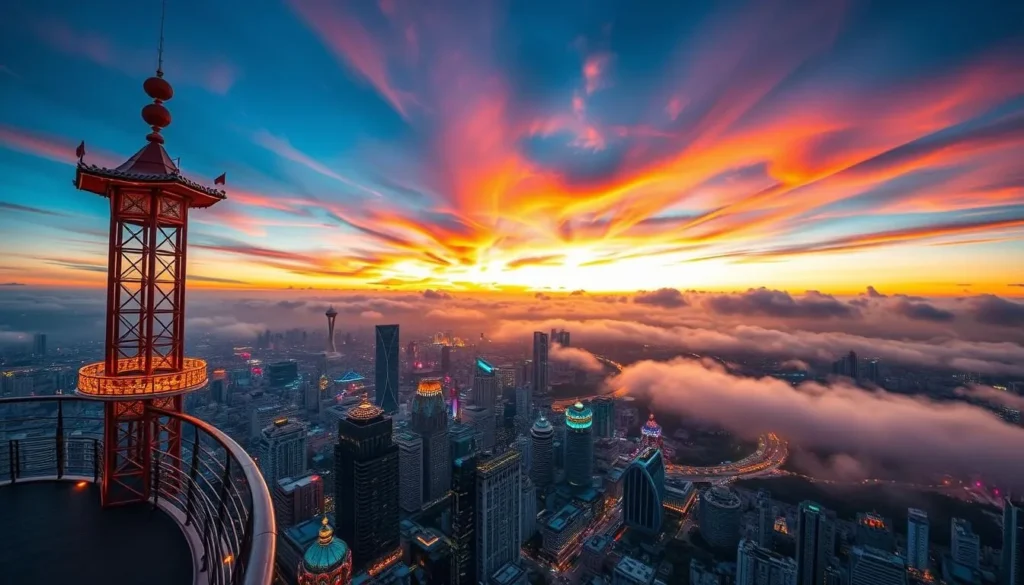
You’ll experience breathtaking panoramic views from the 89th floor observation deck of Zifeng Tower, once the 7th tallest building in the world. The tower’s architectural significance is noteworthy, having been designed by the same firm behind the Burj Khalifa and One World Trade Center.
To make the most of your visit, plan your trip during the best times for optimal visibility. On clear days, you can see all the way to Purple Mountain and beyond.
Nanjing Eye Pedestrian Bridge and Riverside Parks
The Nanjing Eye is an iconic pedestrian bridge spanning the Yangtze River, known for its distinctive eye-shaped design that lights up spectacularly at night. As you walk across the bridge, you’ll enjoy stunning views of the river and the city.
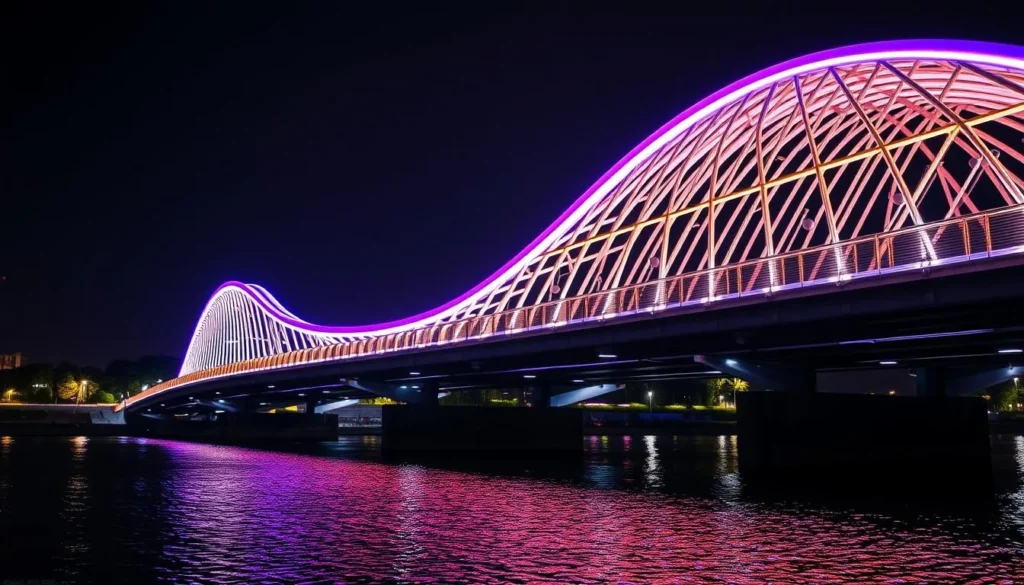
The Nanjing Eye is not just a bridge; it’s an experience. You’ll learn about Nanjing’s riverside parks and modern public spaces that showcase the city’s contemporary urban planning. These areas are perfect for a leisurely stroll or a picnic with family and friends.
For photography enthusiasts, the elevated vantage points, particularly during golden hour and after dark, offer ideal conditions for capturing the best city views.
Culinary Delights: Must-Try Nanjing Specialties
Nanjing, known as the ‘duck capital’ of China, offers a culinary journey like no other. The city’s rich history and cultural heritage are reflected in its diverse and flavorful dishes. As you explore Nanjing, you’ll have the opportunity to try a variety of local specialties that are sure to tantalize your taste buds.
Duck Dishes: Salted Duck, Roast Duck, and Duck Blood Soup
Nanjing is renowned for its duck dishes, which are a staple of the local cuisine. Nanjing Salted Duck, also known as Jinling Roast Duck, is a must-try. This dish is characterized by its tender and juicy meat on the inside, with a crispy exterior, creating a delightful texture contrast. Unlike Beijing’s roast duck, Nanjing Salted Duck is served without wheat flour pancakes or cucumbers, allowing the natural flavor of the duck to shine.
Another popular duck dish is Duck Blood Soup, a heart-warming soup made with duck blood, glass noodles, tofu, and offal in a savory broth. For an authentic experience, visit Xiao Pan Ji Ya Xie Fen Si Tang, a recommended restaurant for this local favorite.
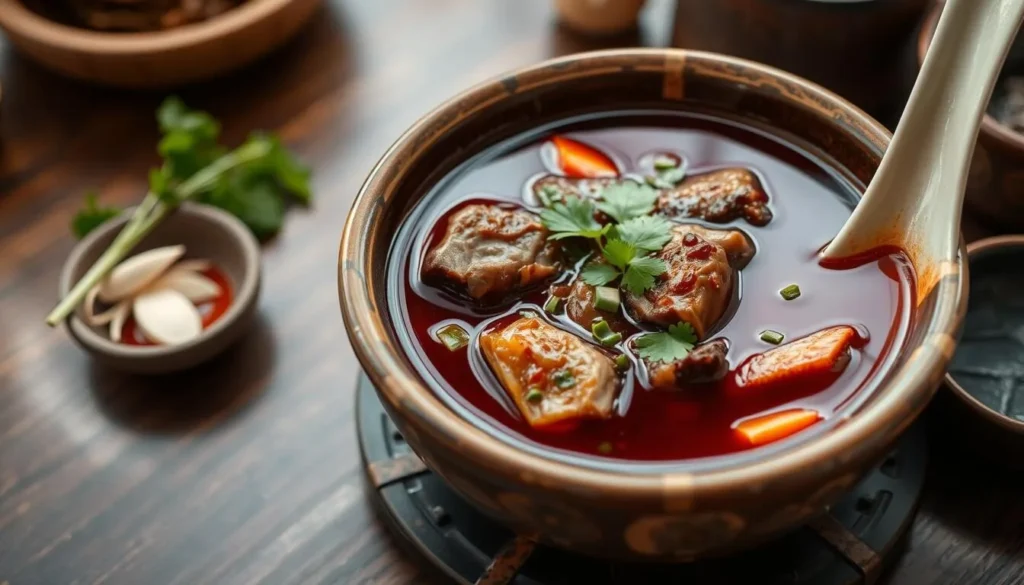
Local Delicacies: Lion’s Head Meatballs and Tangbao
Beyond duck dishes, Nanjing offers other local delicacies that are worth trying. Lion’s Head Meatballs are oversized, juicy pork meatballs stewed in a rich broth, sometimes topped with decadent crab roe. These meatballs are named for their resemblance to a lion’s head and are a testament to the city’s culinary creativity.
Tangbao, or steamed buns stuffed with juicy pork, are Nanjing’s answer to soup dumplings. These delicate buns burst with flavorful broth and tender pork filling, making them a must-try for visitors.
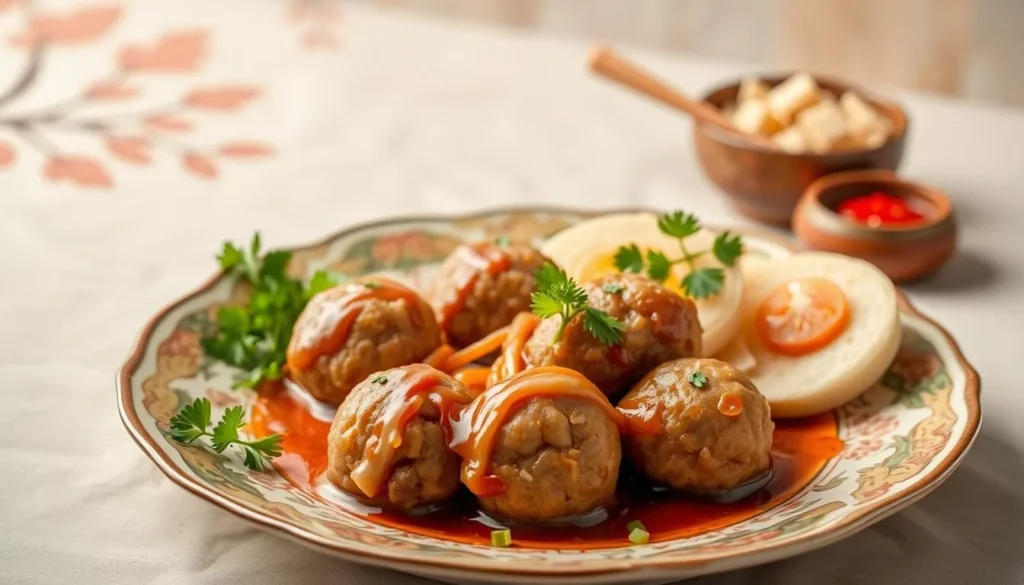
Street Food and Snacks: Sesame Pancakes and Stinky Tofu
Nanjing’s street food scene is vibrant and diverse, offering a range of snacks that are both delicious and affordable. Sesame Pancakes, or ya you shao bing, are flaky, golden pastries often enriched with duck fat for extra flavor. Sometimes filled with sweet or savory ingredients, these pancakes are a popular local snack.
For the more adventurous, Stinky Tofu is a fermented delicacy featuring a crispy exterior with a uniquely pungent yet addictive flavor. This street-food staple is a must-try when exploring Nanjing’s culinary landscape.
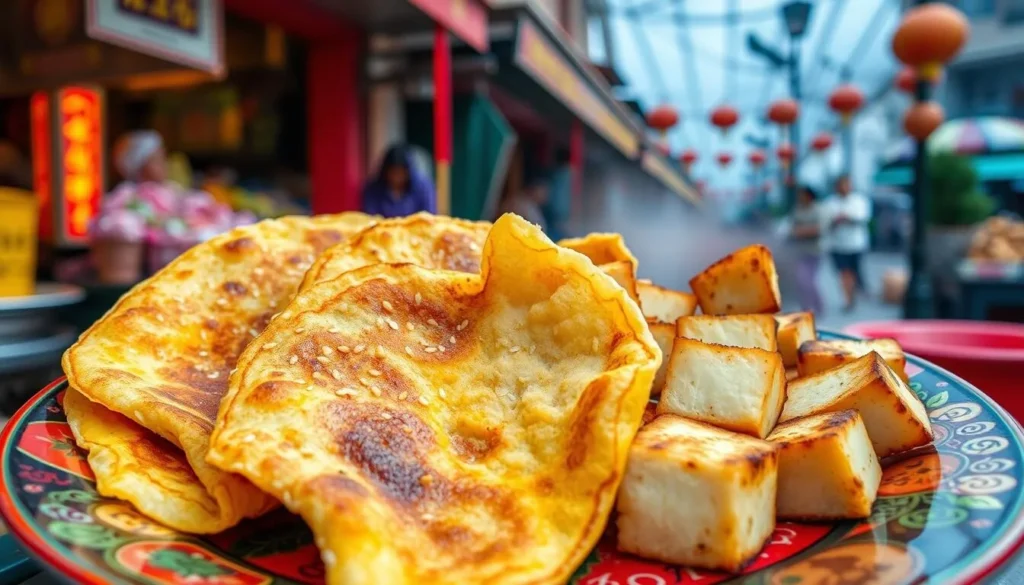
As you explore Nanjing’s culinary delights, you’ll discover why the city is considered China’s “duck capital,” with specialties that rival Beijing’s famous roast duck. From signature duck dishes to local delicacies and street food favorites, Nanjing offers a culinary experience that is both authentic and unforgettable.
Where to Eat in Nanjing: Top Restaurant Recommendations
Nanjing’s culinary landscape is characterized by its rich history, cultural influences, and local ingredients, making it a food lover’s paradise. You’ll discover a wide range of dining options that showcase the city’s unique flavor profile.
Traditional Dining Establishments
For an authentic taste of Nanjing, you should visit some of the city’s top-rated traditional restaurants. Plum Garden at the Jinling Hotel is renowned for its authentic Nanjing Salted Duck. Other must-try establishments include Xiao Pan Ji Ya Xie Fen Si Tang for Duck Blood Soup and Jiangnan Wok · Yun for Lion’s Head Meatballs.
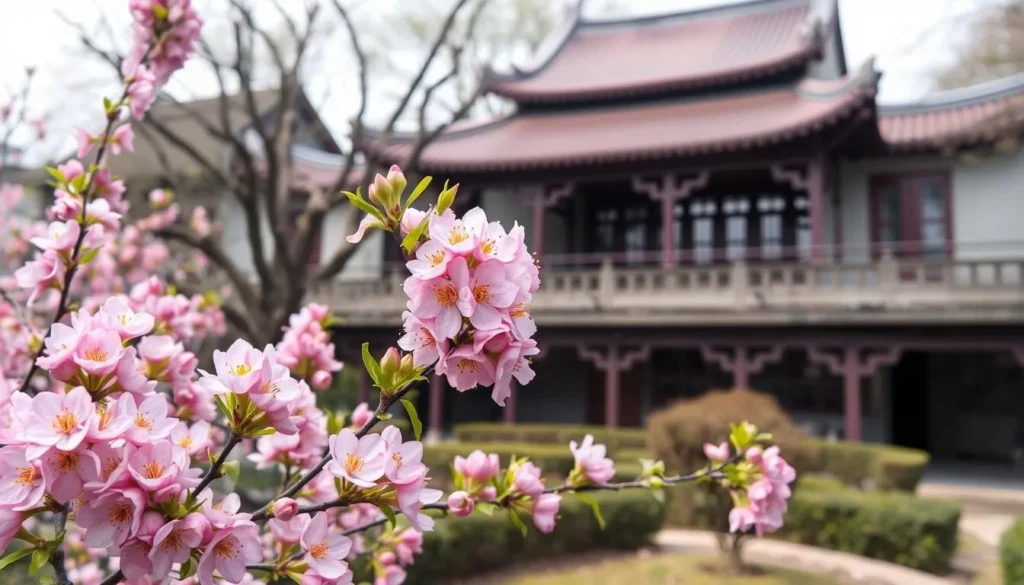
Family-run eateries like Hao Po Tang Bao offer perfectly crafted soup dumplings, providing a truly local experience. You’ll also find traditional eateries serving other local specialties, such as Stinky Tofu at Pin Ning Fu and Pan-Fried Beef Dumplings at Li Ji Qing Zhen Guan.
Modern and International Cuisine Options
Nanjing’s modern dining scene is also worth exploring, with innovative chefs putting contemporary spins on traditional Jiangsu cuisine. You’ll find a curated list of restaurants near major attractions, making it easy to plan memorable meals during your travel itinerary.
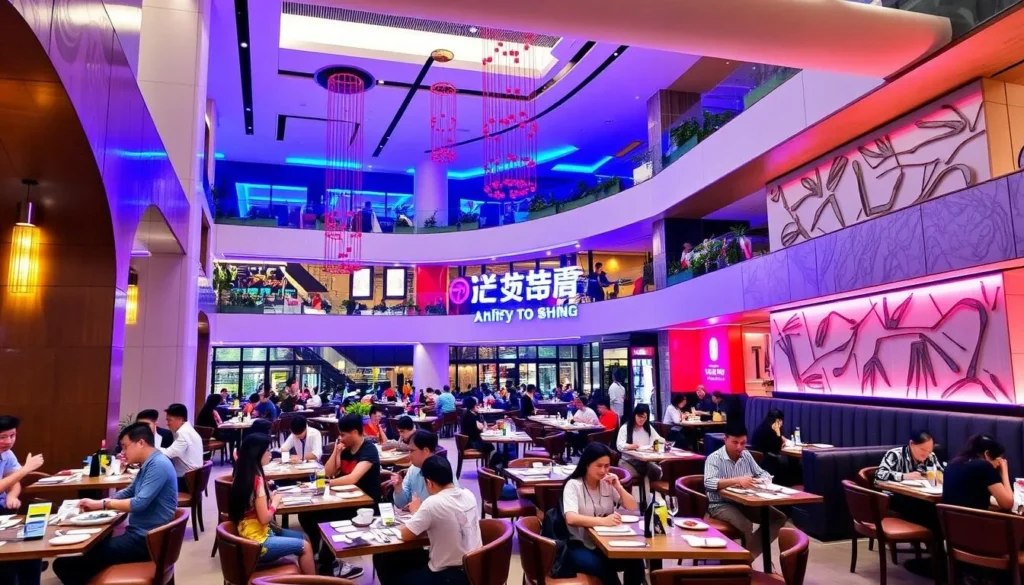
From humble street food stalls to elegant fine dining experiences, Nanjing offers options for every budget. Whether you’re in the mood for traditional Nanjing cuisine or international flavors, you’ll find a restaurant that suits your taste.
Shopping in Nanjing: Souvenirs and Local Products
Nanjing, a city steeped in history and culture, offers a diverse range of unique souvenirs and local products that reflect its rich heritage. As you explore the city, you’ll find numerous opportunities to purchase traditional crafts, local specialties, and cultural artifacts that make perfect mementos of your trip.
Traditional Crafts
Nanjing is renowned for its traditional crafts, which include Yuhua stones, Yunjin brocade, and bamboo carvings. Yuhua stones, also known as Rain Flower stones, are a natural agate that can be found in various forms, such as fine jewelry, vases, or pebbles, at the Nanjing Yuhua Stone Museum.

Yunjin brocade, a type of Chinese silk fabric, is a UNESCO-recognized cultural heritage that once adorned imperial robes. You can find authentic Yunjin brocade products, such as scarves, clothing, and accessories, in local markets and specialty stores.
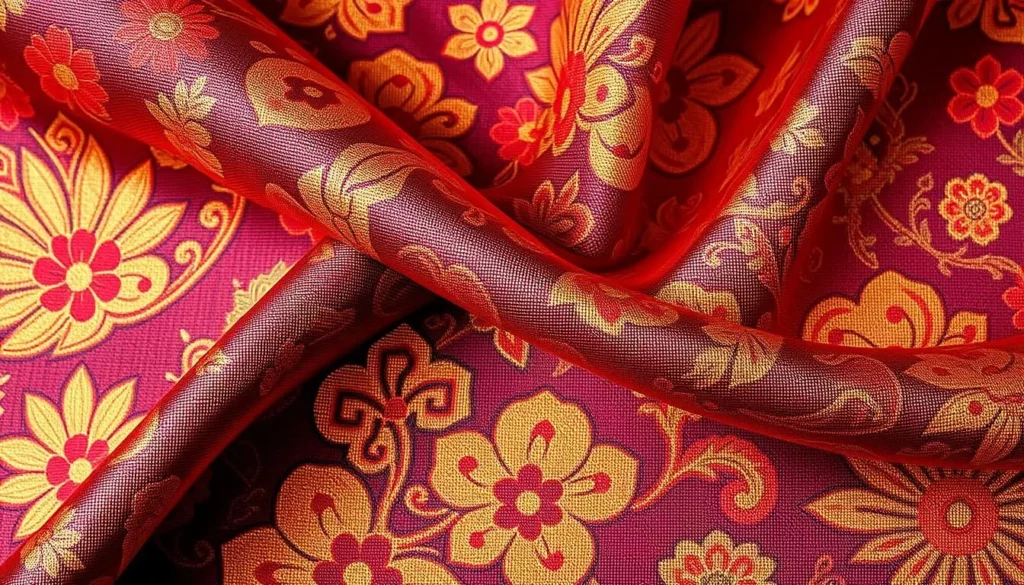
Bamboo carvings are another traditional craft that showcases Nanjing’s artistic heritage. You can find intricately carved bamboo products, such as figurines, ornaments, and decorative items, in local shops and markets.
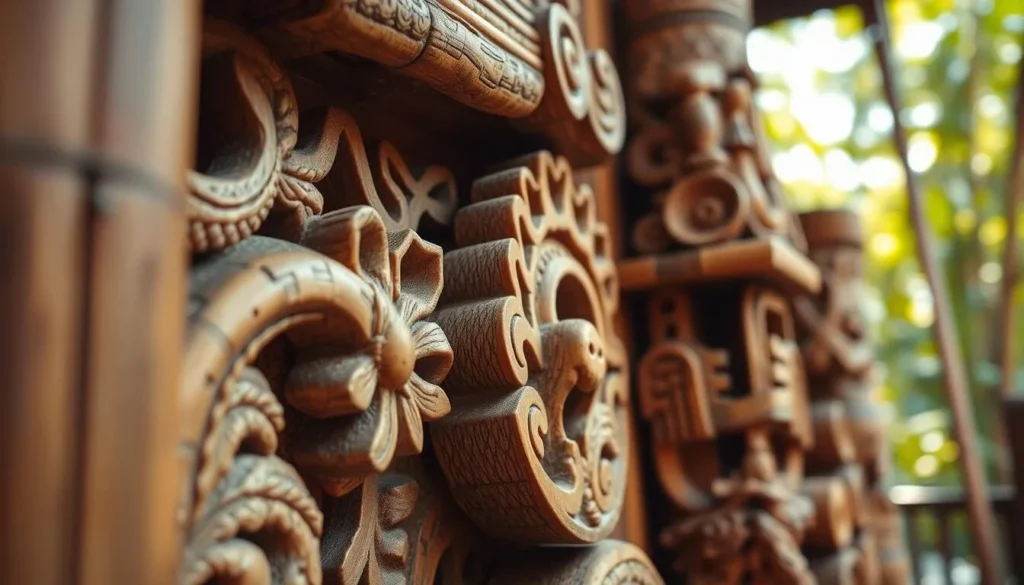
Shopping Districts
Nanjing’s shopping districts offer a range of shopping experiences, from traditional markets to modern malls. Xinjiekou is a popular shopping area known for its upscale boutiques and department stores, while Hunan Road offers a more leisurely shopping experience along a pedestrian street lined with food options.
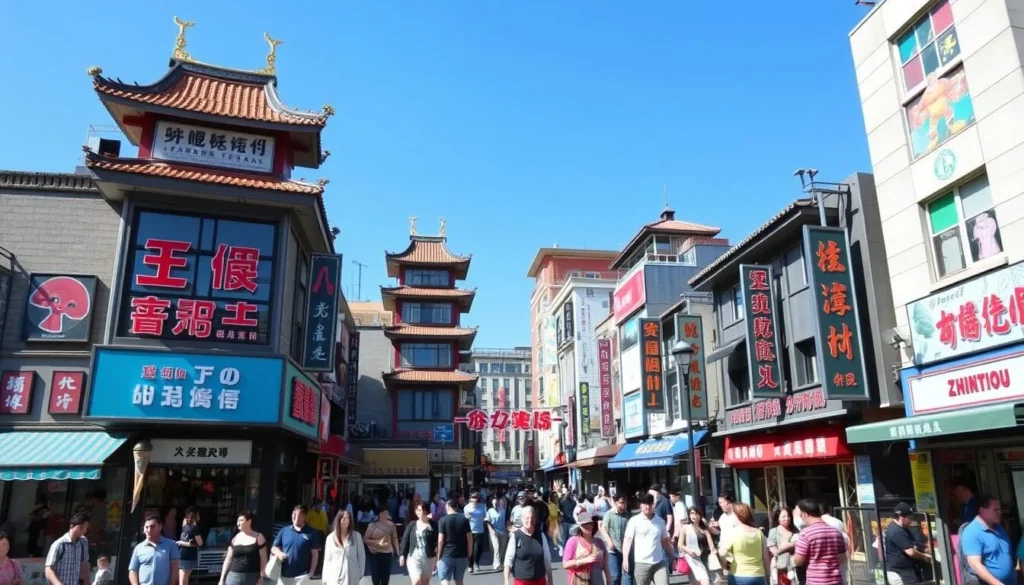
For a more local shopping experience, head to the Qinhuai River area near the Confucius Temple, where you can find traditional souvenirs, local produce, and cultural artifacts. The Aqua City Shopping Center, located across from the Confucius Temple, offers an upscale shopping experience with international brands.
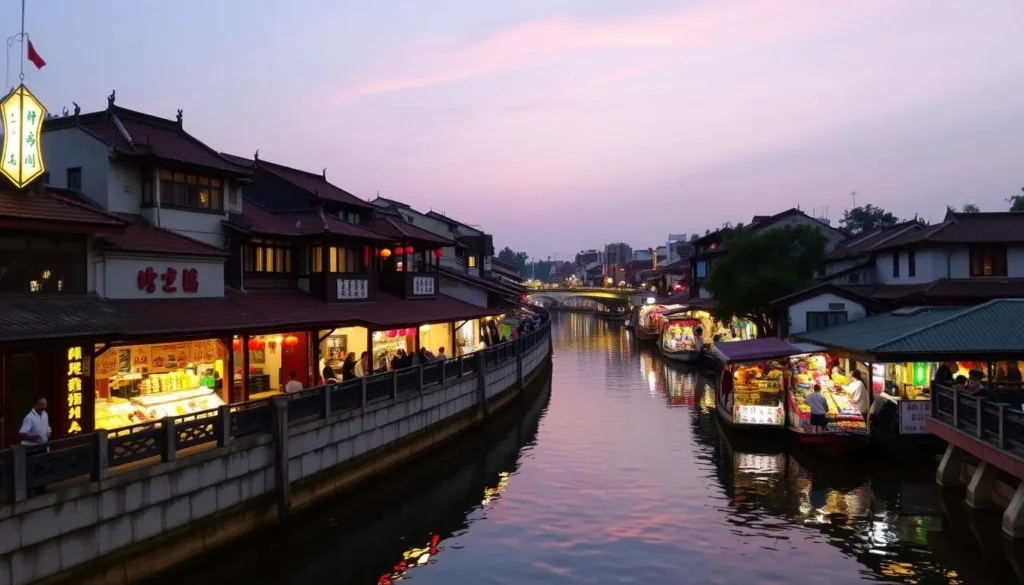
Whether you’re looking for traditional crafts, local specialties, or modern shopping experiences, Nanjing’s shopping districts have something to offer. Be sure to explore the city’s diverse shopping areas to find the perfect souvenirs and local products to bring back home.
Seasonal Activities and Special Experiences
Nanjing transforms into a vibrant playground throughout the year, offering a diverse range of activities tailored to every season. Whether you’re looking for outdoor adventures or cultural experiences, the city has something to offer.
Summer Boating and Water Activities
Summer is the perfect time to enjoy Nanjing’s serene waters. You can rent a paddle boat and explore Xuanwu Lake, gliding among the towering lotus flowers that bloom in July. The lake offers a unique experience, with its picturesque views and tranquil atmosphere. For an added thrill, take an evening ride along the Qinhuai River, where lanterns illuminate the water, creating a magical ambiance.
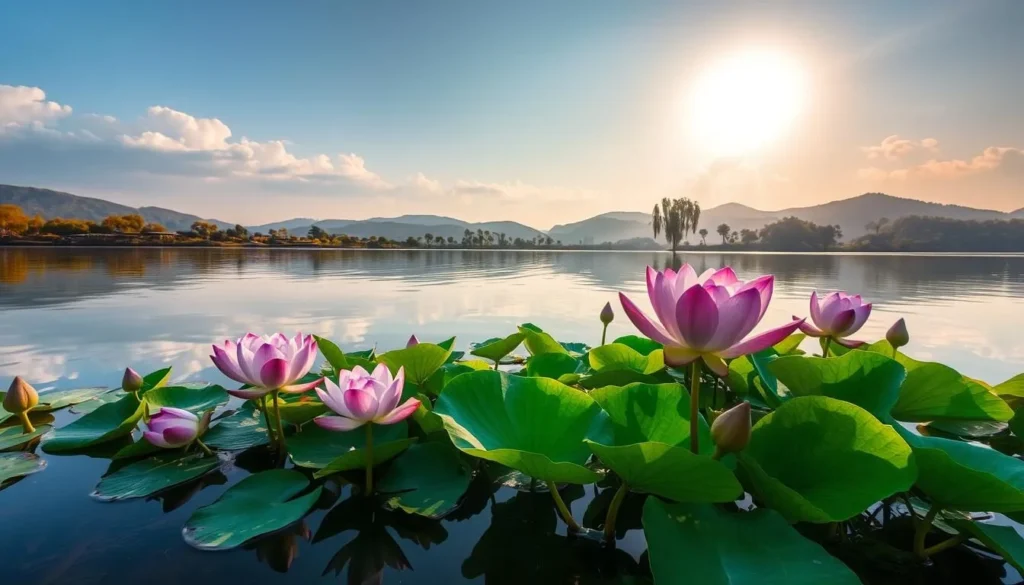
Winter Festivals and Indoor Attractions
As winter sets in, Nanjing comes alive with festive celebrations. The Qinhuai Lantern Festival during Chinese New Year is a spectacle not to be missed, with its vibrant lanterns and cultural performances. On colder days, you can warm up at one of the city’s many indoor attractions, such as world-class museums or traditional tea houses, enjoying the warm air and local hospitality.
These seasonal activities and special experiences make Nanjing a year-round destination, offering something new and exciting with every visit.
Day Trips from Nanjing
You can enhance your Nanjing travel experience by taking day trips to nearby towns and landscapes that showcase the region’s rich history and natural beauty. The surrounding area is dotted with historical towns, natural landscapes, and cultural sites that are easily accessible for a day trip.
Nearby Historical Towns and Natural Landscapes
One of the top day trip destinations from Nanjing is Yangzhou, a historic canal town famous for its classical gardens and Ming-Qing dynasty architecture. You can stroll along the serene canals, visit ancient temples, and admire the town’s well-preserved traditional architecture. Another must-visit destination is Zhouzhuang, one of China’s most famous water towns, known for its network of canals and well-preserved Qing dynasty buildings.
For nature lovers, Tangshan Hot Springs and Laoshan National Forest Park offer refreshing escapes from urban sightseeing. You can relax in the hot springs, enjoy hiking trails, or simply take in the breathtaking scenery. These destinations provide a great opportunity to experience the region’s diverse culture and natural beauty.
Transportation Options and Tour Recommendations
To make the most of your day trips, you can choose from various transportation options, including public transit, organized tours, or private car services. For those who prefer a hassle-free experience, organized tours are available, offering guided itineraries that include transportation and sightseeing highlights.
When planning your trip, consider the travel time and schedule to ensure you make the most of your day. With a little planning, you can enjoy a stress-free and enjoyable day trip from Nanjing. Whether you’re interested in history, culture, or nature, there’s a day trip destination near Nanjing that’s sure to captivate you.
Conclusion: Planning Your Perfect Nanjing Itinerary
Crafting the perfect Nanjing itinerary requires a deep understanding of the city’s hidden gems and popular attractions. To help you make the most of your visit, we’ve put together some sample itineraries ranging from a focused 2-day visit to a comprehensive 5-day exploration.
For a 2-day visit, consider grouping attractions by location. For example, you can spend a day exploring Purple Mountain, visiting the Sun Yat-sen Mausoleum and other historical sites in the area. On the second day, focus on the city center, visiting the Presidential Palace, Confucius Temple, and Nanjing Museum.
When planning your itinerary, remember to balance historical sites with cultural experiences and natural attractions. Take a stroll along the Qinhuai River, visit the Nanjing Massacre Memorial, and enjoy the city views from the top of the Zifeng Tower. Don’t forget to incorporate seasonal highlights, such as plum blossom viewing in spring or autumn foliage at Maple Color City.
To make the most of your time, consider the best sequence for visiting attractions. For instance, visit the City Wall early in the morning to avoid the heat and crowds. You can also take a Qinhuai River cruise in the evening to enjoy the city’s illuminated landmarks.
By following these tips and sample itineraries, you’ll be able to create a personalized Nanjing itinerary that suits your interests and travel style. Whether you’re interested in history, culture, or architecture, Nanjing has something to offer, making it a must-visit destination in China.
The above is subject to change.
Check back often to TRAVEL.COM for the latest travel tips and deals.
